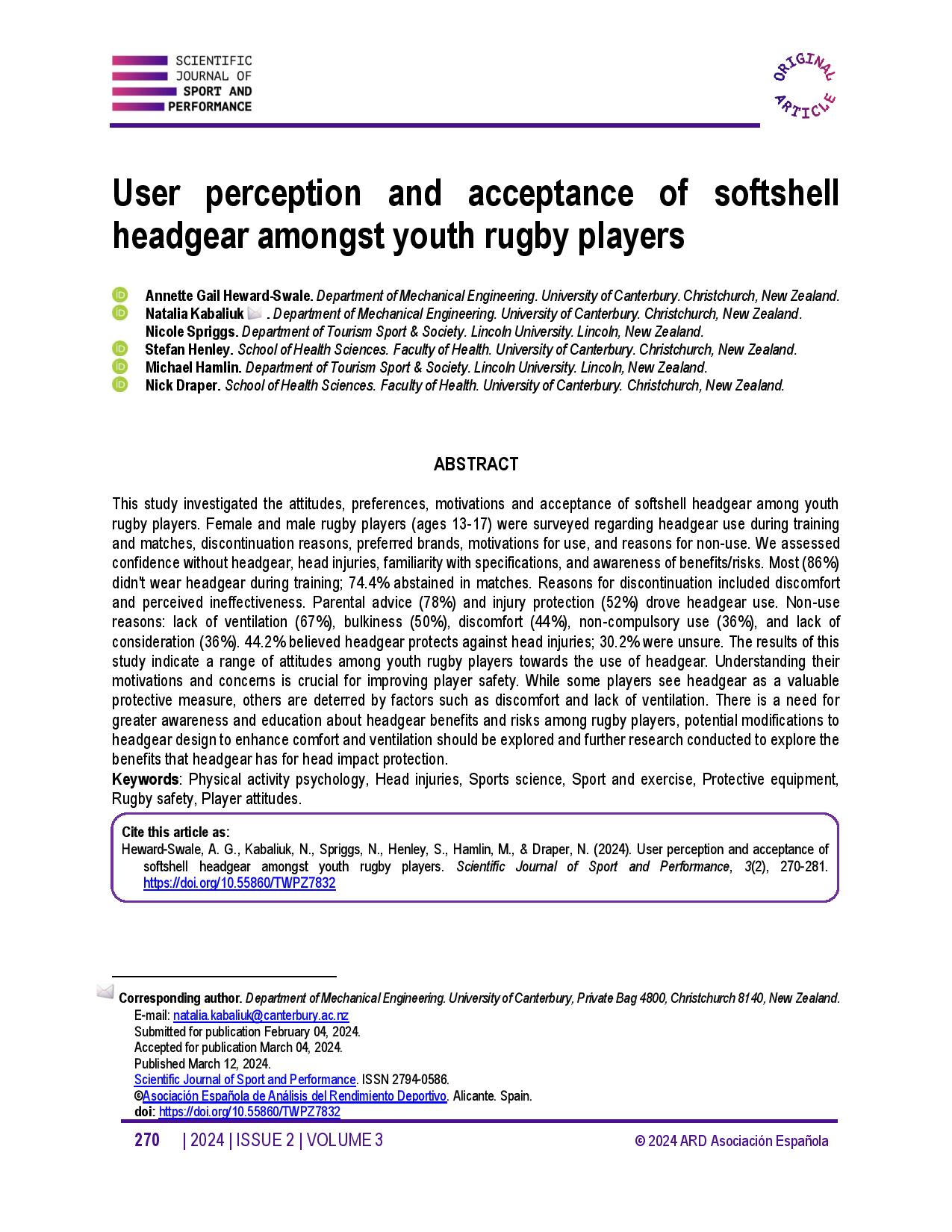User perception and acceptance of softshell headgear amongst youth rugby players
Main Article Content
Abstract
This study investigated the attitudes, preferences, motivations and acceptance of softshell headgear among youth rugby players. Female and male rugby players (ages 13-17) were surveyed regarding headgear use during training and matches, discontinuation reasons, preferred brands, motivations for use, and reasons for non-use. We assessed confidence without headgear, head injuries, familiarity with specifications, and awareness of benefits/risks. Most (86%) didn't wear headgear during training; 74.4% abstained in matches. Reasons for discontinuation included discomfort and perceived ineffectiveness. Parental advice (78%) and injury protection (52%) drove headgear use. Non-use reasons: lack of ventilation (67%), bulkiness (50%), discomfort (44%), non-compulsory use (36%), and lack of consideration (36%). 44.2% believed headgear protects against head injuries; 30.2% were unsure. The results of this study indicate a range of attitudes among youth rugby players towards the use of headgear. Understanding their motivations and concerns is crucial for improving player safety. While some players see headgear as a valuable protective measure, others are deterred by factors such as discomfort and lack of ventilation. There is a need for greater awareness and education about headgear benefits and risks among rugby players, potential modifications to headgear design to enhance comfort and ventilation should be explored and further research conducted to explore the benefits that headgear has for head impact protection.
Article Details

This work is licensed under a Creative Commons Attribution-NonCommercial-ShareAlike 4.0 International License.
References
Finch, C. F., McIntosh, A. S., & McCrory, P. (2001). What do under 15 year old schoolboy rugby union players think about protective headgear? Br J Sports Med, 35(2), 89. https://doi.org/10.1136/bjsm.35.2.89 DOI: https://doi.org/10.1136/bjsm.35.2.89
Freitag, A., Kirkwood, G., Scharer, S., Ofori-Asenso, R., & Pollock, A. M. (2016). Systematic review of rugby injuries in children and adolescents under 21 years. Br J Sports Med, 50(8), 511. https://doi.org/10.1136/bjsports-2014-093684 DOI: https://doi.org/10.1136/bjsports-2014-093684
Fuller, C. W., Taylor, A., Kemp, S. P. T., & Raftery, M. (2017). Rugby World Cup 2015: World Rugby injury surveillance study. Br J Sports Med, 51(1), 51-57. https://doi.org/10.1136/bjsports-2016-096275 DOI: https://doi.org/10.1136/bjsports-2016-096275
King, D., Hume, P., Gissane, C., Brughelli, M., & Clark, T. (2016). The Influence of Head Impact Threshold for Reporting Data in Contact and Collision Sports: Systematic Review and Original Data Analysis. Sports Medicine, 46(2), 151-169. https://doi.org/10.1007/s40279-015-0423-7 DOI: https://doi.org/10.1007/s40279-015-0423-7
King, D. A., Hume, P. A., Milburn, P., & Gianotti, S. (2009). Rugby league injuries in New Zealand: a review of 8 years of Accident Compensation Corporation injury entitlement claims and costs. Br J Sports Med, 43(8), 595-602. https://doi.org/10.1136/bjsm.2009.061481 DOI: https://doi.org/10.1136/bjsm.2009.061481
Makovec Knight, J., Nguyen, J. V. K., Mitra, B., & Willmott, C. (2021). Soft-shell headgear, concussion and injury prevention in youth team collision sports: a systematic review. BMJ Open, 11(6), e044320. https://doi.org/10.1136/bmjopen-2020-044320 DOI: https://doi.org/10.1136/bmjopen-2020-044320
Menger, R., Menger, A., & Nanda, A. (2016). Rugby headgear and concussion prevention: misconceptions could increase aggressive play. Neurosurg Focus, 40(4), E12. https://doi.org/10.3171/2016.1.FOCUS15615 DOI: https://doi.org/10.3171/2016.1.FOCUS15615
New Zealand Rugby. (2023). Get Involved. New Zealand Rugby. Retrieved from [Accessed March 04, 2024]: https://www.nzrugby.co.nz/get-involved/
Pettersen, J. A. (2002). Does rugby headgear prevent concussion? Attitudes of Canadian players and coaches. Br J Sports Med, 36(1), 19-22. https://doi.org/10.1136/bjsm.36.1.19 DOI: https://doi.org/10.1136/bjsm.36.1.19
Pfister, T., Pfister, K., Hagel, B., Ghali, W. A., & Ronksley, P. E. (2016). The incidence of concussion in youth sports: a systematic review and meta-analysis. Br J Sports Med, 50(5), 292-297. https://doi.org/10.1136/bjsports-2015-094978 DOI: https://doi.org/10.1136/bjsports-2015-094978
Quarrie, K., Gianotti, S., & Murphy, I. (2020). Injury Risk in New Zealand Rugby Union: A Nationwide Study of Injury Insurance Claims from 2005 to 2017. Sports Med, 50(2), 415-428. https://doi.org/10.1007/s40279-019-01176-9 DOI: https://doi.org/10.1007/s40279-019-01176-9
Quarrie, K. L., Alsop, J. C., Waller, A. E., Bird, Y. N., Marshall, S. W., & Chalmers, D. J. (2001). The New Zealand rugby injury and performance project. VI. A prospective cohort study of risk factors for injury in rugby union football. Br J Sports Med, 35(3), 157. https://doi.org/10.1136/bjsm.35.3.157 DOI: https://doi.org/10.1136/bjsm.35.3.157
Schneider, D. K., Grandhi, R. K., Bansal, P., Kuntz, G. E. t., Webster, K. E., Logan, K., Barber Foss, K. D., & Myer, G. D. (2017). Current state of concussion prevention strategies: a systematic review and meta-analysis of prospective, controlled studies. Br J Sports Med, 51(20), 1473-1482. https://doi.org/10.1136/bjsports-2015-095645 DOI: https://doi.org/10.1136/bjsports-2015-095645
Silver, D., Brown, N., & Gissane, C. (2018). Reported concussion incidence in youth community Rugby Union and parental assessment of post head injury cognitive recovery using the King-Devick test. J Neurol Sci, 388, 40-46. https://doi.org/10.1016/j.jns.2018.02.046 DOI: https://doi.org/10.1016/j.jns.2018.02.046
World Rugby. (2021). World Rugby Year in Review 2021. World Rugby. Retrieved from [Accessed March 04, 2024]: https://www.world.rugby/organisation/about-us/annual-reports




